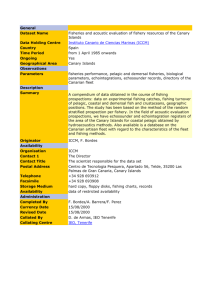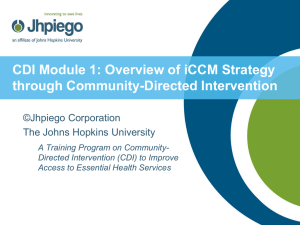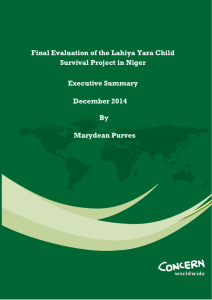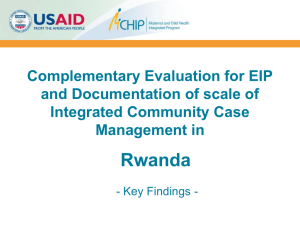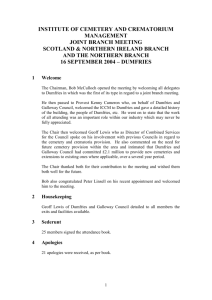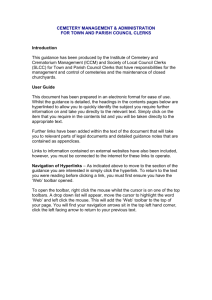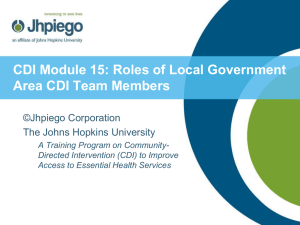Evidence, Ideas and Integrated Community Case
advertisement
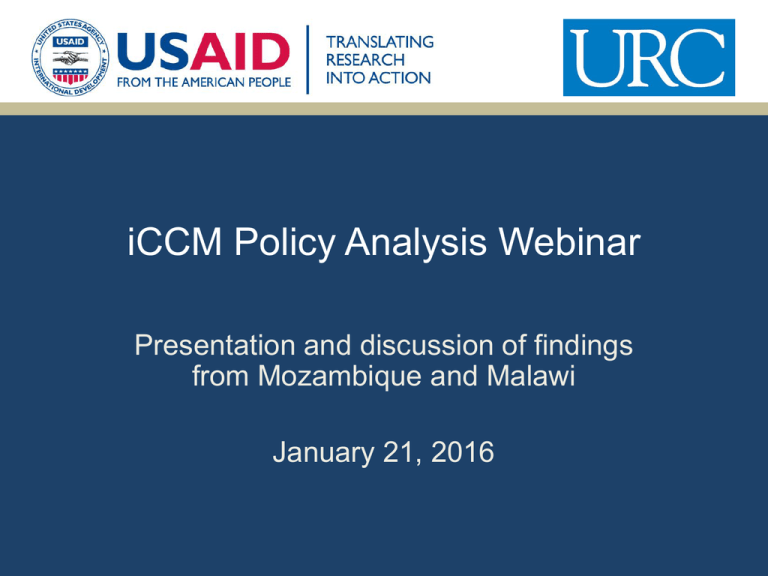
iCCM Policy Analysis Webinar Presentation and discussion of findings from Mozambique and Malawi January 21, 2016 Policy Analysis of Integrated Community Case Management of Childhood Illnesses: Introduction to a Six-Country Case Study Sara C. Bennett Johns Hopkins University Bloomberg School of Public Health, on behalf of the iCCM Policy Study Team TRAction iCCM Webinar, 21st January 2016 Coverage of essential child health services in Sub-Saharan Africa • 31% of children with diarrhea receive ORS • 37% of children with fever receive any antimalarial • 39% of children with symptoms of pneumonia receive antibiotics (Unicef 2014) • Large gap in coverage of essential services • Many children dying at home without reaching a health facility Joint statements on integrated Community Case Management • Between 2004 and 2012 WHO and UNICEF produced a series of joint statements on iCCM Defining iCCM The integrated delivery for children under 5 of: – Treatment for childhood pneumonia with antibiotics, – Treatment for diarrhea with zinc and low osmolarity ORS, – Treatment for malaria with artemisinin combination therapy (ACTs), and – Home visits of newborns with treatment of neonatal sepsis with antibiotics …by community or lay health workers at household and/or community levels. Progress in adopting & implementing iCCM • By 2013 out of 44 Sub-Saharan African countries:– 36 had written policies or plans for CCM of diarrhea – 35 for malaria – 31 for pneumonia (Rasanathan 2014) • Implementation somewhat uneven – fast progress in some countries, much slower in others THE ICCM POLICY ANALYSIS STUDY Policy Analysis of iCCM • How do we explain the uneven progress in adopting and implementing iCCM? • What are the barriers and facilitators to policy adoption and implementation? For example:– Is there active resistance from specific stakeholders such as clinicians? – Are there objectives to the content of the proposed policy? – Do policy-makers feel that they have sufficient evidence to proceed? Study Objective • In-depth analysis of national policy change for iCCM in six sub-Saharan African countries to understand whether, how and why iCCM policies were developed, including barriers and facilitators to policy change. • Aims: – Document and analyze the specific expressions of policy – Identify facilitators or barriers to policy and program change – Assess the role of ideas and evidence in policy and program development – Identify policy elements that enable the eventual implementation Policy Analysis Triangle Context Source: Walt & Gilson 1994 Actors -Individuals - Groups -Organizations Content Process Qualitative Retrospective Country Case Studies varying by -policy status -nature of CHW cadre -sub-regions Mali Burkina Faso Niger Kenya Malawi Mozambique *iCCM Policy Study Team Team Institutional Partner Core team members Jessica Shearer (McMaster University) Burkina Faso Kenya Great Lakes UniversityPamela A. Juma Kisumu Malawi REACH Trust Ireen Namakhoma, Hastings Banda Mali MARIKANI Brahima Diallo, Mamadou Konate Mozambique Universidade Eduardo Mondlane Baltazar Chilundo, Alda Mariano, Julie Cliff Niger LASDEL Sarah Dalgish (JHSPH) and Aissa Diarra (LASDEL) JHSPH Core Team Sara Bennett, Asha George, Daniela Rodriguez, Jessica Shearer Study Methods • Document review • Semi-structured interviews: – Stakeholders in iCCM policy: Government officials, development partners and multilateral organizations, bilateral donors, civil society organizations, research institutions, etc. – Start with respondents identified in document review, and snowball until saturation • Fieldwork undertaken April – September 2012 • Thematic analysis using NVivo software by country and JHSPH researchers Data Collection Country Number approached Number interviewed Number documents reviewed Burkina Faso 30 25 80+ Mali 35 33 33 Niger 37 32 113 Kenya 31 19 41 Malawi 30 20 29 Mozambique 40 21 50 Acknowledgements Funding from • Sincere appreciation to study participants for sharing their time with us. iCCM Policy Development in Malawi TRAction Project Webinar 21 January 2016 Ireen Namakhoma, REACH Trust Daniela C. Rodriguez, Johns Hopkins School of Public Health iCCM policy in Malawi • iCCM was developed in 2007 (part of larger child survival policy) started implementation in 2009 via a cadre of paid community health workers known as HSAs (Health Surveillance Assistants) • iCCM covers malaria, pneumonia, diarrhea, neonatal sepsis (limited) as well as conjunctivitis • iCCM is targeted at hard-to-reach areas (e.g. beyond 8km radius from health facility) Serious questions about implementation of iCCM were raised during policy development, how were they addressed? Main findings Contributing factors to iCCM policy development Innovation characteristics • Perceived need for innovation: • Child survival was a persistent problem, as highlighted by various sources of evidence • Facility IMCI was not reaching children in communities • Lancet series on child survival offered plausible interventions • Innovation and system compatibility • The health worker shortage had led to the expansion of the HSA cadre so HSAs seen as viable delivery mechanism for iCCM system readiness • Earlier experiences with IMCI and other health improvement programs aimed at community level (e.g. DRF, BMHI) system antecedents Institution characteristics • Leadership: • Process led by MOH through consultative process that engaged Child Health TWG • Engaged development partners to address key implementation questions • Coordination among partners: • Despite the MOH’s leadership in policy development, getting internal agreement within MOH was challenging • MOH coordinated across stakeholders, incl. other Ministries, and presented plans to districts • Development partners, esp. UNICEF and WHO, played a supportive role to policy development and acted as knowledge brokers Institution characteristics, cont. • Organizational capacity: • Professional organizations raised concerns about training and regulation of HSAs, but were overcome • HSA supervision and overburdening were challenges raised during policy development*** • Planned funding was felt to be inadequate for long-term implementation of iCCM*** • Funds for iCCM are channeled through the SWAp, but with substantial external support from donors*** ***Still unresolved after 3 years of implementation Implications of findings Implications of the findings for local country context • Need for improved coordination of partners in iCCM implementation especially at district and sub district level • Government should commit to funding iCCM activities e.g through raising budget allocation to health (to meet 15% Abuja declaration) • Need for strengthened HSA supervision, monitoring and motivation. Post-study developments Developments contributing towards improving iCCM • The findings contributed to development of the new Malawi Child Health Strategy 2014-2020 • Has particular section tackling strategies for strengthening iCCM • Strategy recognizes need for sustainable funding • New supervision guideline manual developed • REACH Trust under REACHOUT consortium with support from EU has been piloting peer and group HSA supervision approaches • Introduction of amoxyllin- dispersible tablets for pneumonia for HSAs THANK YOU Re-launch of the official Community Health Worker Program in Mozambique: Is there a sustainable basis for iCCM policy? Baltazar Chilundo (MD, PhD), Julie Cliff (FRCP, MScCHDC), Alda Mariano (MD, MSc), Daniela Rodriguez (DrPH), Asha George (DrPH) 30 Analysis of sustainability of the official CHW program and of iCCM policy Context Research question Methods Results Concluding remarks and implications 31 Context Remarkable progress of reduction of child mortality Trends of Mozambican child mortality 1997 to 2011 Under 1 month Under 12 month Under 5 years 300 Government and partners recognize that more gains are possible if there is more emphasis on effective interventions at the community level 250 245.3 200 154 150 101 100 50 138 143.7 57 97 93 64 48 42 30 0 DHS 1997 DHS 2003 MICS 2008 DHS 2011 32 Context The official CHW government Program known as Elementary Polyvalent Agents “Agentes Polivalentes Elementares” was established in 1978 and it functioned with innumerous operational challenges, being suspended in 1989, but it was relaunched in 2010 thanks to its potential impact: % distribution of U5 causes of mortality in Mozambique (INE, 2007) Other 29% Malaria 42% Measles 1% Majority of causes of mortality Undernutrition among children are of “ easy 2% Diarrhea solution” with emphasis on iCCM by 6% CHW Pnuemonia AIDS 14% 6% 33 Context and Research question CHWs trained for four months to carry out promoting / preventive (80%), first aid, activities treatment of common diseases especially in children such as Malaria, Pneumonia, Diarrhea and referral of more serious cases = iCCM Given the past history of decline, a key issue is whether the current revitalization of the CHW program allows for a more sustainable basis. Does the current revitalization of the CHW program, which encapsulates iCCM, exhibit characteristics that facilitate or impede its sustainability? Methods Study design Qualitative: retrospective case study (Yin, 2009) done simultaneously across 6 SSA countries (+ Burkina Faso, Kenya, Mali, Malawi, Niger) Data collection Performed in Maputo city, in 2012 Literature review (n = 54) Key informant interviews (n=21) Analysis Thematic analysis using an Nvivo codebook Thematic analysis using a sustainability framework (Schell et al. 2013) Facilitators of and barriers to CHW sustainability for the domains: Strategic Planning Organizational capacity Program adaptation M&E Communication Funding stability Political support Partnership Public Health impact 36 Findings: Strategic Planning Facilitators • CHW program developed in a consultative manner across MOH departments and with partners • National policies and guidelines reviewed to avoid mistakes made in the past, e.g. APE non-payment. • After consultative process with drug regulatory agencies, MOH exercised fiat regarding drug regulations allowing APEs to prescribe certain medicines and mainstreaming medicines into the NHS and CHW kit Barriers • Poor coordination with MOH departments • Ministry of Finance not included in consultations • APEs have short-term contracts, low pay ( not full-time salary), and no career path, causing potential retention problems • CHWs not integrated into the civil service, due to their educational level, despite precedence from other Ministries on how to incorporate community level agents into government structures 37 Findings: Organizational Capacity Facilitators • Operational guidelines and tools developed • APEs trained in standardized manner • APEs equipped with necessary equipment and supplies to carry out their tasks • NGOs with programme experience willing to support supervision and logistics Barriers • Weak supply chain, with frequent medicine stock-outs may demotivate APEs and the community • Weak supportive supervision systems • Dependence on NGOs/ partners and difficulties with harmonization may weaken government health systems and oversight 38 Findings: Funding stability Barriers only Program is entirely dependent on external donors for salaries, drugs, supplies, supervision, etc. Scale up is slow (36% = 2.270/6.343 APE) as government requires partners to pay for APEs comprehensively and not just for training Funding partners targeting specific provinces and districts, leaving others without support, leading to geodiscrepancy in service delivery and unequal distribution of APEs Weak and decreasing contribution of the state budget to the health sector FUNDING SOURCE BY DISTRICT, 2012 Adapted from UNICEF (2013). Data from MISAU – APE Program UNICEF/CIDA SAVE THE CHILDREN/UNICEF/CIDA SAVE THE CHILDREN MALARIA CONSORTIUM PNG/UNICEF/USAID UNICEF/USAID HELP AGE WORLD VISION Decrease of external support to the health sector, pending response from Global Fund audit recommendations WORLD BANK UNICEF/CIDA/WORLD BANK WITHOUT APEs Figure 1. Heterogeneity and multiplicity of funding sources to the APE programme in Mozambique by districts, 2012 39 Concluding remarks and implications Without careful attention to finance, human resources, supply chain management, and quality assurance, the CHW program including iCCM may yield disappointing results. To ensure sustainability, the government should commit itself to fund the program from the state budget This study was presented to the health authorities and partners in National Health Congress in September 2015 and within the TWG of public health directorate at the MOH Partially thanks to this study MOH/Unicef are commissioning development of the 1st strategic plan for the official CHW 2016 – 2020 which includes the need to define funding strategies taking into account a scenario of sustainability 40 Muito obrigado! Thanks 41 Reactions from our discussants Rory Nefdt Dyness Kasungami iCCM Policy Analysis Findings from Mozambique and Malawi Q&A Please write in your questions in the chat box iCCM Policy Analysis Findings from Mozambique and Malawi Thank you! You can access the recording of this webinar and the link to the HPP supplement at www.tractionproject.org iCCM Policy Analysis Findings from Mozambique and Malawi
